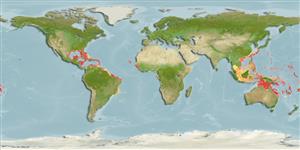>
Callionymiformes (Dragonets) >
Callionymidae (Dragonets)
Etymology: Callionymus: Greek, kallion, comparative of kallos = beautiful + Greek, onyma = name; with a better name.
Eponymy: Spencer Fullerton Baird (1823–1887) was an American zoologist and giant of American ornithology. [...] (Ref. 128868), visit book page.
More on author: Jordan.
Environment: milieu / climate zone / depth range / distribution range
Écologie
marin récifal; océanodrome (Ref. 51243); profondeur 1 - 91 m (Ref. 7251). Tropical; 32°N -
Western Atlantic: Canada (Ref. 5951) to Bermuda, southern Florida (USA), and the Bahamas to northern South America.
Taille / Poids / Âge
Maturity: Lm ? range ? - ? cm
Max length : 11.4 cm TL mâle / non sexé; (Ref. 7251)
Épines dorsales (Total) : 4; Rayons mous dorsaux (Total) : 9; Épines anales: 0; Rayons mous anaux: 8. Preopercular spine has 3 or more teeth on top and 1 forward-projecting spine on bottom (Ref. 26938). Males have an elevated first dorsal fin (Ref. 13442).
Inhabits shallow reefs, including Thalassia testudinum beds (Ref. 13628).
Life cycle and mating behavior
Maturité | Reproduction | Frai | Œufs | Fécondité | Larves
Robins, C.R. and G.C. Ray, 1986. A field guide to Atlantic coast fishes of North America. Houghton Mifflin Company, Boston, U.S.A. 354 p. (Ref. 7251)
Statut dans la liste rouge de l'IUCN (Ref. 130435: Version 2024-1)
Menace pour l'homme
Harmless
Utilisations par l'homme
Pêcheries: commercial; Aquarium: Commercial
Outils
Articles particuliers
Télécharger en XML
Sources Internet
Estimates based on models
Preferred temperature (Ref.
123201): 24.1 - 28.3, mean 27 °C (based on 606 cells).
Phylogenetic diversity index (Ref.
82804): PD
50 = 0.5000 [Uniqueness, from 0.5 = low to 2.0 = high].
Bayesian length-weight: a=0.00389 (0.00180 - 0.00842), b=3.12 (2.94 - 3.30), in cm total length, based on all LWR estimates for this body shape (Ref.
93245).
Niveau trophique (Ref.
69278): 3.3 ±0.4 se; based on size and trophs of closest relatives
Résilience (Ref.
120179): Haut, temps minimum de doublement de population inférieur à 15 mois (Preliminary K or Fecundity.).
Fishing Vulnerability (Ref.
59153): Low vulnerability (10 of 100).
Nutrients (Ref.
124155): Calcium = 128 [66, 198] mg/100g; Iron = 0.774 [0.473, 1.287] mg/100g; Protein = 18.3 [17.2, 19.3] %; Omega3 = 0.112 [0.066, 0.193] g/100g; Selenium = 33.9 [16.8, 70.3] μg/100g; VitaminA = 109 [35, 327] μg/100g; Zinc = 1.85 [1.25, 2.59] mg/100g (wet weight);
